French Alps Travel Guide
The breathtaking French Alps are a playground for winter sports enthusiasts and hikers and, apart from the world-renowned ski resorts, there are charming medieval villages, beautiful lakes and ancient cities such as Grenoble to be explored.
First and foremost, any mention of the French Alps summons images of idyllic skiing and snowboarding on some of the best and most extensive slopes in Europe. There is an amazing variety of resorts to choose from. Young resorts such as Flaine (purpose-built, modern and extremely user-friendly, with access to all the wonders of the famous 'Le Grand Massif' ski area) will impress seasoned skiers. Lesser-known gems such as the small Samoëns, a picturesque medieval village and the only French resort to be designated an historical monument, will delight those who demand culture as well as sport.
The French Alps are also popular in the summer months when sailing and hiking become the activities of choice. Visitors flock to the beautifully situated lake-side and mountain villages of the region for picnics, walks and some historical sightseeing among the natural splendour.
Best time to visit the French Alps
The French Alps get a lot of sun during the year and the most popular time to visit for hikers and climbers is between July and September, when the weather is warm and predictable and the high snows have melted. The ski season runs from late November to April and the slopes are busiest over the Christmas and Easter holidays.
What to see in the French Alps
-Sightsee in the picturesque old town of Briançon, the highest town in France.
-Visit the beautiful Parc Naturel Regional du Vercors.
-Go museum-hopping in Grenoble, the 'Capital of the Alps'.
-Share a kiss on the Lovers' Bridge in Annecy.
What to do in the French Alps
-Take a cruise on Lac du Bourget, the largest natural freshwater lake in France.
-Enjoy the spa facilities at Evian-les-Bains.
-Hike up La Tournette mountain, near Annecy, for glorious views.
-Hit the ski slopes of Chamonix or the Trois Vallées ski area.
Getting there
EuroAirport Basel-Mulhouse-Freiburg, located on the border of Switzerland, France and Germany, is one of the best airports servicing the French Alps region. The airport is under four miles (6km) northwest of Basel, Switzerland, and 14 miles (22km) southeast of Mulhouse France, and there is a regular bus service to numerous French villages and resorts. Chambéry-Savoie Airport, located six miles (about 10km) north of Chambéry, is another option. Alpes-Isere Airport, located 28 miles (45km) from Grenoble, is a small but very popular airport.
Did you know?
-The highest peak in the Alps is Mont Blanc, which stands at 15,771 feet (4,807m), making it the highest peak in Western Europe.
-Snow rests permanently on the French Alps above the altitude of 9,186 feet (2,800m).
-Grenoble is the biggest city in the Alps, with about 500,000 inhabitants.
Things to do in French Alps
Aix-les-Bains and Evian-les-Bains are both popular resort towns in the French Alps. Aix-les-Bains is a spa town, located on the banks of Lac du Bourget, loved for its thermal springs, and Evian-les-Bains, situated on the southern tip of Lake Geneva, is famous for its mineral water. Both are hotspots for healthy spa holidays and offer a variety of outdoor activities among other things. Annecy is also a popular lake-side village, often called 'the Venice of the Alps' in tribute to its picturesque canals. Annecy is a good base for hikers as there are many spectacular trails in the Haute-Savoie region.
Another hikers' paradise is the mountain village of Briançon, the highest town in France, which boasts a lovely historical old town in addition to its natural splendours. Some of the ski resorts are also perfect bases for hikers and climbers in the summer months and two of the best for this purpose are Chamonix and Samoëns. Samoëns is one of the smaller French ski resorts and is a pretty medieval village that has been declared an historical monument.
Grenoble, the biggest city in the region dating back 2,000 years, is also a good base for active excursions into the countryside, as this beautiful city is surrounded by dramatic mountains and valleys. It's a vibrant university city and offers great sightseeing options.
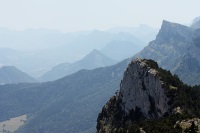
Grenoble
The beautiful university town of Grenoble, known in France as the 'Capital of the Alps', is situated on the Drac and Isère Rivers, and is surrounded by proud mountains, dramatic gorges and hidden valleys. The city's history goes back 2,000 years and visitors can still see the last remnants of the Roman wall that fortified the city in 286 AD. Grenoble is also known in modern history for its resistance efforts during World War II.
Today it is a prosperous, lively and cosmopolitan city, well-known for its industrial and scientific advances and a base for companies involved in the chemical, nuclear research and electronics industries. More obviously to visitors, it is home to 40,000 students, many international. There are some excellent walks among the mountains surrounding the city and there are ski slopes within easy driving distance; visitors should head to the Parc Naturel Regional du Vercors for stunning landscapes and outdoor activities. For many tourists Grenoble is simply a stopover before heading further into the Alps, but the city has plenty of attractions of its own.
Before visiting, it's worth taking a scenic ride on the distinctive egg-shaped suspended cable cars known as 'Les Bulles'. Grenoble also has some great little museums including the Archaeological Museum, the Musee de Grenoble and the Musee Dauphinois.
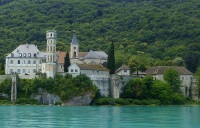
Aix-les-Bains
Aix-les-Bains is a popular and fashionable family holiday resort and spa town located on the eastern side of Lac du Bourget, the largest natural freshwater lake in France. Although the lake is icy cold, visitors can sail, fish, play golf and tennis, or picnic on the parkland at the water's edge. Taking a cruise on the lake for a few hours is a must.
The main town of Aix is two miles (3km) inland from the lake and has been built around its thermal springs. Many small hotels line the streets, and streams of holiday visitors take to the baths each day; in the evening, for a change of pace, they play the slot machines at the Aix-les-Bains casino or attend tea dances. The Musee Faure is a great art gallery boasting the second largest collection of Rodin's work in France, as well as art by Bonnard, Degas, Pissaro and Cezanne.
The old Benedictine Abbey, Abbaye d'Hautecombe, is also definitely worth a visit: this gothic building is stunningly situated on the lake and can be reached either by boat or by driving along the lovely, winding road. The abbey houses some very significant tombs including that of the last king of Italy.
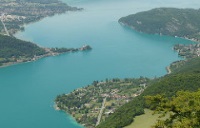
Annecy
Situated 80 miles (129km) east of Lyon, the holiday destination of Annecy has a magical setting on the shore of Lake Annecy, at the foot of the French Alps. It has been called the 'Venice of the Alps' because of the web of canals that cut through the Annecy old town. Annecy is probably the best base for a holiday in the Haute-Savoie region as it's conveniently situated near many interesting towns and attractions.
Just six miles (10km) to its west is Gorges du Fier, a dramatic river gorge; a gangway takes visitors through a narrow gully that has been cut by a torrent of water over the eons. Emerging from this labyrinth, visitors are greeted by a huge expanse of boulders. The site is closed to the public between mid-October and mid-March. Visitors can also take a cruise on the ice-blue lake for which the town is famous.
The area is great for hiking and one of the most popular (though not easy) hikes is on La Tournette mountain, which gives visitors astounding views of the lake and the Alps and boasts some picturesque waterfalls. The trail is well marked and the steepest rock scrambles have rails installed. La Tournette looms over the small town of Montmin, a pretty 30-minute drive from Annecy.
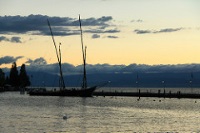
Evian-les-Bains
Evian-les-Bains, on the southern end of Lake Geneva, is famous for its mineral water, which has been bottled since the early 18th century, when tests revealed that the water has astonishing curative qualities and it began to be used for medicinal purposes. Evian is a popular holiday spot with the French as well as foreign visitors, with the majority of travellers coming to this chic holiday resort principally to enjoy the creature comforts and spa facilities of the deluxe Evian-les-Bains hotels. The town has been a fashionable resort since the early 1800s, and much of its architecture comes from that century and the 1920s, making it an attractive city to stroll through.
Aside from the springs, there are many things to do in Evian-les-Bains, including golf, sailing, hiking, river rafting and rock climbing. The Lac Leman offers many activities and a visit to Evian-les-Bains is incomplete without a boating excursion of some kind to continue the liquid tradition of the place. One of the many attractions visitors can reach by boat is Les Jardins de L'eau du Pre Curieux where one can tour the gardens and water museum. The Casino d'Evian, the largest themed casino in Europe, is also a big draw for some visitors.
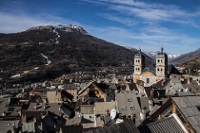
Briançon
Perched among the French Alps, Briançon is the highest town in Europe. The town is divided into the lower town, where the Durance and Guisane rivers meet and much of the modern amenities lie; and the walled and fortified upper town, which was built in the 17th century to defend the town from Austria and so contains the most interesting historical sights.
Briançon is a paradise for outdoor sports enthusiasts. Part of the massive Serre-Chevalier ski area, which also includes Saint-Chaffrey, La Salle le Alpes, and Monêtier les Bains, it enjoys up to 300 days of sunshine per year. But the town is a popular tourist area in summer as well, drawing visitors to see its citadelle, forts, and sundials, as well as to enjoy activities such as hiking, kayaking and rock climbing.
Briançon is also the site of one of the most thrilling stages of the Tour de France. Situated only six miles (10km) from the Italian border, Briançon has a distinctly Italian feel compared to other towns in Provence. There are a number of good pizzerias and some lively bars popular with tourists, but few French restaurants.
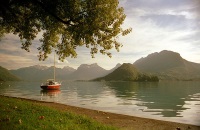
Talloires
The small village of Talloires has fashioned a booming tourist industry from the very best in raw ingredients: medieval architecture, charming locals, and picturesque surroundings ripe with opportunity for both summer and winter sports. Lake Annecy is filled with holidaymakers swimming, sailing and waterskiing in the summer and land-based activities such as golf, hiking, paragliding, horseback riding and tennis are also popular. In the winter, Talloires takes advantage of its location near several popular French ski resorts, including Megève, Espace Diamant, and La Clusaz.
The area of Talloires has been settled since Neolithic times and the village has a rich history and a number of old buildings. The abbey dates back to 1016, although the current structure was built in 1681. Tufts University has its European Center in the 11th-century structure that was once the Benedictine priory in Talloires. For those more interested in historical sightseeing than outdoor activities, strolling the streets of the town is rewarding. And visitors should be sure to sample the delicious local cuisine as well, as the town has some top-notch restaurants.
French Alps Climate and Weather
The French Alps offer lots of sunshine, but cold weather from November to April when the ski season is in full swing. The resorts are generally high and the snow is excellent, although the weather is relatively mild in comparison to the North American resorts. The northern French Alps, which are exposed to westerly winds blowing in off the Atlantic, often receive a lot more snow in winter than areas further to the east, which have a drier and colder continental climate. In the summer months, the northern French Alps enjoy a warm, temperate climate, with fairly frequent summer storms that keep the region lush and green. The alpine spring is very beautiful with wild flowers blooming all over the mountain pastures. The southern part of the French Alps is generally dry but the highest areas do receive sufficient snow in winter to provide excellent skiing conditions. During the summer months the cool, sunny weather attracts hikers and climbers.
The French Alps are a year-round holiday destination. The skiing season runs from November to April and the slopes can get crowded over Christmas and Easter holidays. The best time to visit the French Alps for hiking is between July and September when the weather is sunny and predictable and the high snows have melted.
France travel info
Electricity
The electrical current is 230 volts, 50Hz. European two-pin plugs are standard.
Language
French is the official language.
Money
The euro (EUR) is the official currency in France. Currency can be exchanged at banks, bureaux de change and some large hotels, though visitors will get a better exchange rate at the ATMs. Major credit cards are widely accepted, particularly in major tourist destinations. Foreign currency is not accepted.
Tipping
Most restaurants and hotels automatically add a 15 percent service charge so a tip is not necessary, although another two to three percent is customary if the service has been good. If service is not included then 15 percent is customary. Taxi drivers expect 10 to 15 percent of the fare, and hairdressers about 10 percent. Hotel staff generally receive about €1.50 a day and tips of about €1 are given to washroom and cloakroom attendants and museum tour guides. Tour bus drivers and guides are also tipped.
Health
No particular vaccinations or medications are required for travel to France. The prevalence of certain tick-borne infections, such as lyme disease, tularemia, tick-borne encephalitis, and rickettsial diseases, mean that travellers should take precautions against ticks if they are travelling in rural or forested areas in warm weather. French hospitals and health facilities are first class. Visitors from other EU countries are entitled to discounted medical treatment and medicines on presentation of a European Health Insurance Card (EHIC). After Brexit, the Global Health Insurance Card (GHIC) replaced the European Health Insurance Card (EHIC) for UK citizens. The GHIC allows UK citizens access to state healthcare during visits to the EU. The GHIC is not valid in Norway, Iceland, Liechtenstein or Switzerland, nor is it an alternative to travel insurance. Otherwise, doctors and hospitals often expect immediate cash payment for health services, so medical insurance is advised.
Safety
While violent crime against tourists is rare and holidays in France are generally trouble-free, visitors should be mindful that security has been heightened following a series of terrorist attacks in recent years, particularly in the transport sector. Unattended luggage left in public places will be removed or destroyed by security staff. While generally safe, visitors to France are advised to take precautions against petty theft and to ensure their personal safety. Thieves and pickpockets operate on the metro and around airports. Theft from cars is prevalent, particularly in the south, around Marseilles, and in Corsica. Tourists are advised to conceal bags and purses even when driving, and to never leave valuables unattended in the car. Bag snatching is also common, particularly on public transport and in shopping centres, and visitors should also be vigilant of luggage while loading bags into and out of hire cars at airports.
Local customs
French culture is of paramount importance to the French people. In an increasingly Americanised world they feel duty-bound to protect it, and it is appreciated if visitors can speak a few words of French. Locals do not respond well to being shouted at in English. While the food is second to none, foreigners may find the service in many restaurants sloppy. Waiters can appear rude (particularly in Paris) and take their time. This is just the way they are. Traditional games such as pétanque (similar to lawn bowling but played on gravel) are popular in village squares, but the national sports are football, rugby and cycling. Smoking in public places is not allowed and will incur heavy fines.
Doing business
Business etiquette is important in France. A smart, fashionable sense of dress is common as the nation prides itself on haut couture. Punctuality is not always observed though and the 'fashionably late' tactic may be applied. A handshake is the common form of greeting for men and women upon first introductions. Titles are important and the person is to be referred to as 'monsieur' (Mr.), 'madame' (Mrs.), or 'mademoiselle' (Ms.). Meetings usually occur over lunches, and the French are known to enjoy food. Business hours are generally 9am to 6pm, Monday to Friday.
Duty free
Travellers from non-EU countries over 17 years of age entering France can bring in the following items duty-free: 200 cigarettes, or 100 cigarillos, or 50 cigars, or 250g tobacco. Four litres of wine and 16 litres of beer and one litre of spirits over 22 percent or two litres of alcoholic beverages less than 22 percent. Other goods up to the value of €430 for air and sea travellers, and €300 for other travellers (reduced to €175 for children under 15 years of age).
Communications
The international access code for France is +33. Travellers can purchase local prepaid SIM cards for unlocked phones or use eSIMs if their cellular providers support it on their networks. Free WiFi is available in most hotels, cafes, restaurants and similar establishments.
Passport & Visa
The borderless region known as the Schengen Area includes the following countries: Austria, Belgium, Czech Republic, Denmark, Estonia, Finland, France, Germany, Greece, Hungary, Iceland, Italy, Latvia, Lithuania, Luxembourg, Malta, The Netherlands, Norway, Poland, Portugal, Slovakia, Slovenia, Spain, Sweden, and Switzerland. All these countries issue a standard Schengen visa that has a multiple entry option, and which allows the holder to travel freely within the borders of all the aforementioned countries.
Additionally, travellers must hold sufficient funds to cover their stay in France, and proof of repatriation (a return or onward ticket, and the necessary travel documentation for their next destination). Note that Schengen visas, if required, are also valid for French Guiana and French West Indies and Reunion, provided that the Schengen visa is endorsed "Also valid for French territories being in observation of the respective French territories". We recommend that passports always be valid for six months after intended period of travel.
Entry requirements
US citizens must have a passport that is valid for at least three months after their intended stay in France. No visa is required for a stay of up to 90 days within a 180 day period.
UK citizens must have a passport that is valid for at least three months after their intended stay in France. No visa is required for a stay of up to 90 days within a 180 day period.
Canadian citizens must have a passport that is valid for three months after their intended stay in France. No visa is required for a stay of up to 90 days in a 180 day period.
Australian citizens must have a passport that is valid for three months after their intended stay in France. No visa is required for a stay of up to 90 days in a 180 day period.
South African citizens must have a passport that is valid for three months after their intended stay, and a valid Schengen visa, to enter France. Note that entry and transit will be refused to holders of Temporary passports.
Irish citizens must have a passport that is valid on arrival. No visa is required.
New Zealand citizens must have a passport that is valid for three months after their intended stay in France. No visa is required for a stay of up to 90 days in a 180 day period.
Useful contacts
Maison de la France (Tourist Information Agency), Paris: www.france.fr/fr
112 (General emergency)Embassies / consulates in other countries
French Embassy, Washington DC, United States: +1 202 944 6195.
French Embassy, London, United Kingdom: +44 (0)20 7073 1000.
French Embassy, Ottawa, Canada: +1 613 789 1795.
French Embassy, Canberra, Australia: +61 (0)2 6216 0100.
French Embassy, Pretoria, South Africa: +27 (0)12 425 1600.
French Embassy, Dublin, Ireland: +353 (0)1 277 5000.
French Embassy, Wellington, New Zealand: +64 (0)4 384 2555.
Embassies / consulates in France
US Embassy, Paris: +33 (0)1 4312 2222.
British Embassy, Paris: +33 (0)1 4451 3100.
Canadian Embassy, Paris: +33 (0)1 4443 2900.
Australian Embassy, Paris: +33 (0)1 4059 3300.
South African Embassy, Paris: +33 (0)1 5359 2323.
Irish Embassy, Paris: +33 (0)1 4417 6700.
New Zealand Embassy, Paris: +33 (0)1 4501 4343.


